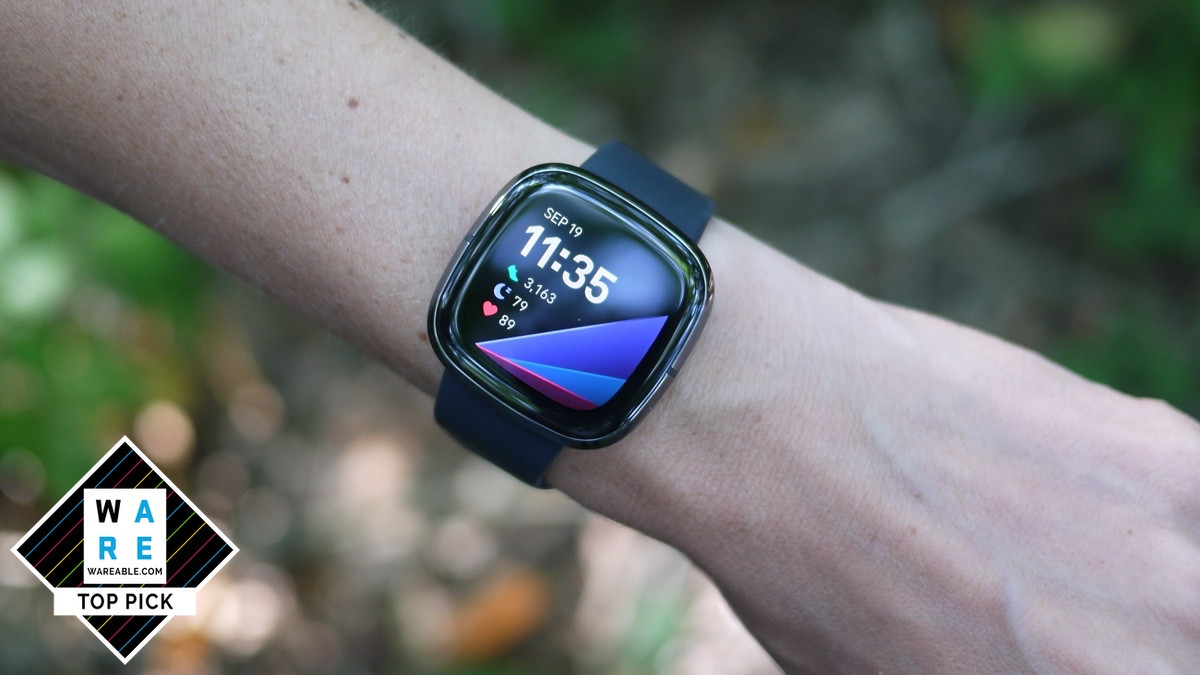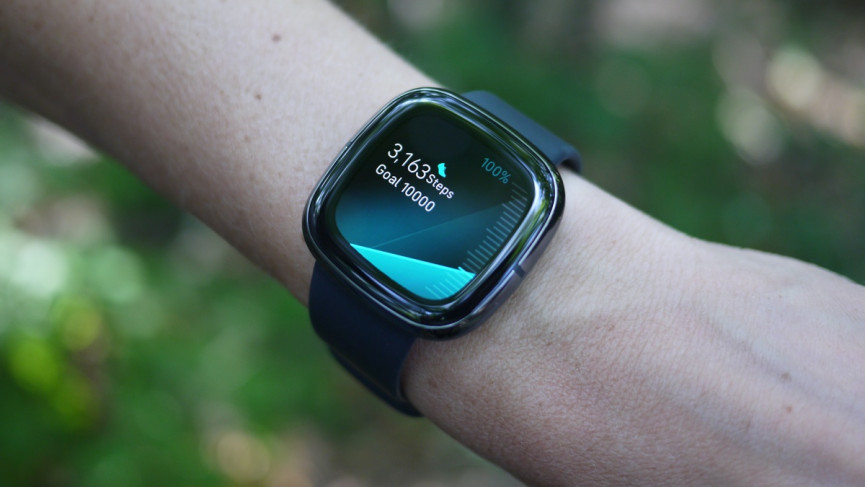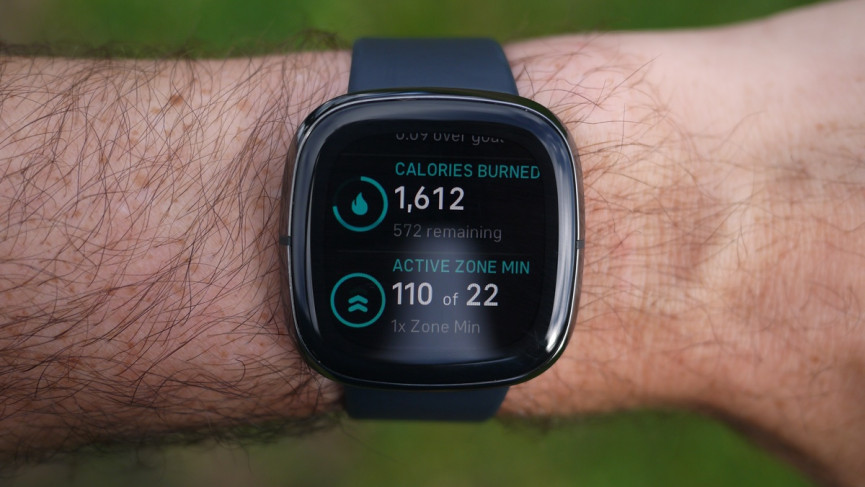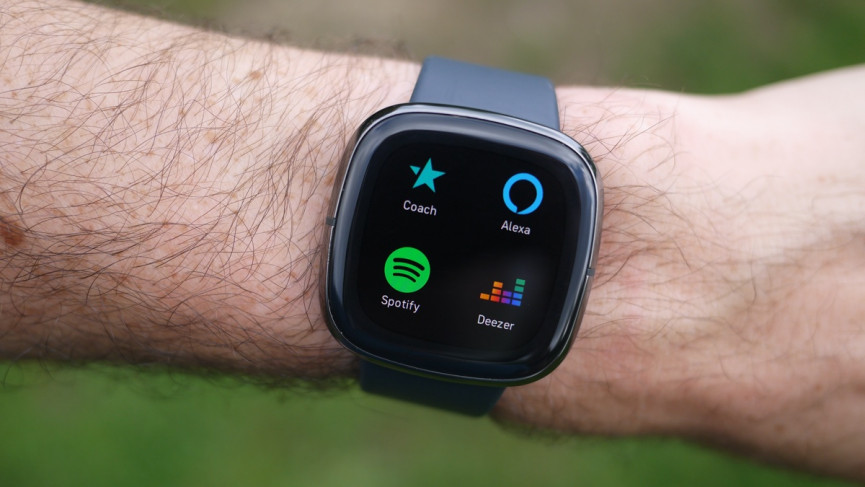
- Health data galore
- Stress and mindfulness
- We love temperature tracking
- Bugs and performance issues
- Insights lacking on key data
- Smartwatch features lagging
The Fitbit Sense is a new line from the fitness tracking company and one that attempts to re-align Fitbit as a health brand instead.
While the Fitbit Sense looks like another Fitbit smartwatch, it’s a health data powerhouse, brimming with sensors designed to put you in touch with the inner workings of your body and mind.
It’s a leap forward in terms of wearable technology and what it can offer - and has more sensors and health data than the Fitbit Versa 3, Fitbit Charge 4 or Fitbit Inspire 2.
But it’s been one the toughest devices we’ve ever had to evaluate. The Sense is still hamstrung by legal and regulatory restrictions that make it big on data, but small on insight. And software bugs, a slow interface, and the reliance on a monthly subscription mean it’s not quite a cut-and-dried recommendation.
But there's a lot to love – and that's reflected in our score. In these strange times, it offers one of the most complete windows into your health and well-being. Here’s our Fitbit Sense review.
- Best Fitbit 2022: pick the right device for you
- Best smartwatches from our reviews
- Fitbit Luxe – all you need to know
Fitbit Sense: Price, rivals, and context
Wareable
Fitbit Sense (left) and Apple Watch SE (right)
The Fitbit Sense is the company's most expensive device and is substantially more than the physically identical Versa 3 – but that misses out on ECG, stress, and temperature data.
It’s cheaper than the Galaxy Watch 3 and the Apple Watch Series 6, both of which feature ECG. But it's more than the Apple Watch SE, which has only basic health features, much like the Versa.
Design and comfort
- Sleek and round
- Unisex fit and swappable straps
- Large 1.58-inch display
- Some performance issues and annoying wrist raise
Wareable
The Fitbit Sense takes the same case as the Fitbit Versa 3, and it’s a somewhat unassuming package.
A round black pebble, it’s as vanilla as it gets. No one can get offended, or excited, about the Fitbit Sense’s design.
The screen is a generous 1.58-inch display that gets crammed into a case that measures just 40.5mm. It’s a clear and crisp 336 x 336 resolution, so there are no complaints about quality.
The size makes it unisex, and we feel that even those with slim wrists won’t have any problem wearing the Sense.
It has quick-change straps, so it’s easy to customize your look – although they are a proprietary fit.
The Fitbit Sense is a touchscreen device, with a single physical button on the left bezel that acts as a home button. We didn’t get on very well with this and felt its position was too far under the rounded bezel and possibly on the wrong side for left-wristed wearing.
Wareable
You swipe in different directions to get different information. It’s a little bit of a learning curve to get used to things and to be honest in three weeks of wear we never really used the weather or core stats widgets from the below swipe.
Performance of the touchscreen, wrist raise, and OS navigation is below what we expect from a smartwatch in 2020.
We found the wrist raise pretty unresponsive so we were often looking at a black screen.
When we switched the display to always on (which nukes the battery to less than two days) the home screen often wouldn’t light up from its low-power state in some arm positions and thus be unresponsive to touch.
Wareable
When you swipe left or right the menu slides across, but swipe down to see widgets and daily stats and it seems to hang and then appear all of a sudden, leaving you in limbo and not knowing whether the swipe was registered.
And we had a few crashes and hangs. Performance across the device was sluggish.
There’s no doubt the Fitbit Sense is an exciting innovation, but as a smartwatch, it’s a poor performer.
Fitbit Sense: Health features
- In-depth stress sensing
- Brilliant temperature data
- Lots of raw info for Premium users
- ECG will land in October 2020
It seems clear that the Fitbit Sense has issues as a smartwatch, but what about it as a health device?
In terms of what it tracks, it’s a monster. So we’re going to review each area separately.
ECG
The Fitbit Sense can take ECG readings – although the feature is due to go live in "mid-October". We'll update this section of the review once we've tried it out and can show you how it works.
The Fitbit Sense will also alert to high/low heart rates too, which can be a sign of arrhythmia. Fortunately, we didn't get any during our review period.
Stress and EDA
Wareable
One of the headline features of the Fitbit Sense is its ability to track stress.
It does this in two ways. First, it uses heart rate technology to offer a daily stress score, but you can also take a fixed reading using the electrodermal activity sensor (EDA). It’s the only smartwatch to have this sensor, but the implementation is unusual.
What’s more, there are guided EDA mindfulness sessions within the app.
Overall, we found the stress score interesting, if a little opaque.
At the start of our review process, we got low scores – indicative of being stressed. However, we didn’t feel mentally or physically stressed. Luckily you can add feedback on your feelings, and perhaps this helped train the sensor, as we quickly resumed to 80-ish scores out of 100.
The stress score works on three parts: heart responsiveness (looking at your natural fight or flight signals from your heart rate), exertion balance (did you get enough exercise), and sleep patterns. You only get to see the breakdown if you get a Premium subscription.
These signals that form the stress score are based on biological signals – so stress in this instance doesn’t necessarily relate to mental health. It could be over-training, over-partying (if only) or just being tired – similar to what you find on Garmin.
A part of the score does come from sleep tracking, which we often feel can be harshly judged, and so feel that the sleep score was too low was also now affecting the stress score.
Wareable
To get a stress score you have to wear the Sense to sleep, and for most of the day. If you forget to put it on for a large portion of the day, you won’t get a score.
The idea is that you’ll head to the mindfulness section of the app to try to do some guided EDA sessions – and that’s the second aspect of the stress offering.
The EDA sensor test is performed on the Sense itself, but you head to the mindfulness section of the app to get the data.
It’s a two-minute test, for which you need to place your palm over the Sense and wait for the vibration to say you’re done.
You get an overview of your heart rate at the start and finish, and how many EDA responses were logged within the 2-minute window. The theory is the more responses detected on your skin, the more stressed you are.
You can also do longer, guided meditations using the EDA sensor throughout.
Given we didn’t feel stressed, our instinct was to ignore this data rather than act on it. Perhaps it’s a good nudge for those who are feeling overwhelmed, to take some action.
Overall, we like stress being added to the Fitbit experience. And those that already enjoy mindfulness will likely find the EDA scan useful – but we’re not sold that we’ve learned anything about ourselves yet. Others may find the data useful as part of a coping mechanism, and we like that the experience is more hands-on that the passive tracking we’ve seen on rival wearables.
Temperature, breathing rate, HRV
Wareable
The Sense is heavy on data, but most of these live in the new Health Metrics dashboard, which is available only to Premium users.
As you may have heard, there’s a global pandemic going on, and we enjoyed having this window into our overall health via Fitbit Sense.
The Health Metrics dashboard shows:
- Skin temperature (also shown on the Dashboard for non-Premium)
- Resting heart rate (also shown in the Heart Rate section for non-Premium)
- Heart rate variability (HRV)
- Breathing rate
- Oxygen saturation
But there’s an element of data overload here, which may undermine usefulness.
Fitbit has proven in its COVID study that it can see the onset of symptoms of illness (not just COVID) among this data. However, it cannot and will not flag this for you. The data is there – but it’s for you to interpret.
Fitbit Sense debuts a temperature reading, which could be our favorite new feature – possibly because it’s the easiest to understand.
Wareable
For the first three days, Fitbit creates a baseline, which is personal to you. Everyone’s temperature varies, so this helps account for someone being 35 degrees while others are 37. Then, while you sleep, the Sense examines whether you are above or below the baseline. Small variations are shown in white, while larger ones are color coded.
You can also take your temperature and enter it as a baseline if you wish.
You’ll then see graphs for resting heart, heart rate variability, breathing rate, and oxygen saturation below.
Even as keen observers of health tech, our experience reading this data is problematic.
And Fitbit cannot analyze what these data points mean for you. Our HRV fluctuated quite a lot through the review period (it did on the Apple Watch too) – but what does that show?
The same applies to breathing rate and resting heart rate and oxygen saturation, which were stable.
I know that an increase in resting heart rate is a sign something is up. But how much of an increase? Likewise, changes in HRV. Is what I am seeing normal? It creates more questions than insights.
If you want lots of data about yourself, presented in a single place, the Fitbit Sense is unparalleled. And we should add these are an optional extra for Premium users, so you don’t have to look at them.
But if talk of heart rate variability, breathing rate, and baseline temperatures causes you to glaze over – this is not the device for you.
Sleep tracking
- Great sleep tracking
- Same experience as Charge 4 and Versa
- Oxygen tracking while you sleep
- Wareable

Fitbit’s strong suit over the last couple of years is sleep, and the company’s tracking is still the best in the business. But there’s little new here over the much cheaper Fitbit Charge 4.
With Fitbit Premium you get a breakdown of duration, sleep stages, heart rate via sleep (and percentage under resting heart rate), and Estimated Oxygen Variation. And all this is mixed up into a single sleep score.
We do find Fitbit a harsh scorer of sleep. It deems us restless every night, with scores of wake-ups often 10 minutes or longer, that we don’t remember.
However, it’s extremely sensitive and you can see the effects of late nights or alcohol on things like heart rate during sleep, which is reassuring.
And as such, while it’s easy to get a pretty crappy sleep score, it’s possible to fix things by focusing on doing the right things: get an early night a few nights in a row, don’t drink alcohol before bed, and have good sleep hygiene.
And it’s usually pretty seamless. However, we did manage to clock up 3 hours of extra sleep when we took the Sense off for a shower, which is something that’s never happened before on a Fitbit, and underlines there are still substantial bugs to work out.
Again, it’s very data heavy. If you want to get deep into data then this is something to buy into. But you can get the same on much cheaper trackers.
Fitness and sports tracking
- Strong fitness tracking
- Accurate GPS
- Heart rate sensor still problematic at high loads
Wareable
Of course, being a Fitbit device there’s plenty of data to get stuck into.
Steps, calories, and floors climbed are all tracked with aplomb, and you get Fitbit’s active zone minutes – this is the new interpretation of active minutes that reward you for getting your heart into higher zones to meet the WHO recommended 150 minutes a week of active time.
We do like the thought behind Active Zone Minutes but have voiced concern that they’re slightly over-complicated. And we do prefer the calorie-focused Move goal on the Apple Watch.
However, as a fitness and activity tracking device it’s as good as things get.
You also get GPS on board, so you can track runs and cycles without a smartphone. And those are just two of the sports profiles on board.
We found run tracking to be accurate with GPS, and you get a good overview of your session in the Fitbit app. You can also kick out to Strava.
Wareable
The Sense debuts PurePulse 2.0, which the company says uses machine learning to improve accuracy – including during exercise.
We’ve found Fitbit sensors to be perfectly accurate at low to medium heart rate load, even up to tempo runs.
However, sadly we still found the PurePulse sensor to perform poorly versus a chest strap at high intensity.
This isn’t unusual, but we were hoping for a boost from PurePulse 2.0. In our side-by-side test with a chest strap the performance across a session matched up well in terms of average HR, but the maximum HR recorded was 179bpm, when the chest strap hit 192bpm.
This shows that the sensor wasn’t able to rise and fall with bursts of effort.
Not everyone will be pushing the sensor in this way, so it doesn’t stop us from recommending the Fitbit Sense. But if you’re looking for top performance at the hardest effort, it’s crucial to know its limitations.
We also tested out other modes, such as yoga. This gives a simple overview of your session – but it’s a shame that elements of stress tracking aren’t incorporated for activities such as yoga.
Smartwatch features
- Poor apps and watch face
- Fitbit Pay still has limited support
- Alexa's usefulness is questionable
- Good notifications
Wareable
We started our review of the Fitbit Sense with some performance complaints, but overall the smartwatch aspects are a tad underwhelming.
We feel that with the Google Buyout looming, Fitbit has taken its software as far as it can go – and while it's driving forward with health insights, the platform has stalled.
Notifications are delivered well, but we have endured a recurring bug where hundreds of historic calendar events come through at once.
Wareable
You can also select apps from which you want to receive notifications which is a nice touch.
But there are aspects of Fitbit Sense that are just way behind rivals.
The app selection is really poor, and we couldn’t find much value worth downloading.
The watch face experience is also disappointing. The Sense can only store six watch faces, which take ages to swap in the app. You can also download more, but some third-party ones require registering online before you can use them, which is just a bad experience.
Fitbit Pay is on board, but it didn’t work with our quite major bank. That’s unfortunate as many UK banks are supported but show that the experience is still way behind Apple Pay.
There is a speaker on board, and Fitbit tells us this will soon support calls from the wrist. Android users will also be able to speak text replies.
You do get Alexa, and you will be able to choose Google Assistant instead. You press and hold to summon Alexa and then speak your command. Alexa won't speak back, however, and all responses are text-based.
Wareable
It works well, and we controlled aspects of our smart home, checked the weather, etc all with success. But it wasn't hard to flummox Alexa. You have to ask Alexa to ask Fitbit to do stuff, for example, which is just a clunky experience.
"Tell me a joke" wasn't understood. And "how many steps have I done today" was met with confusion, because you have to say "ask Fitbit how many steps I've done today."
In short, Alexa doesn't feel very useful – and it's a feature we can't really see getting under your skin.
Battery life
- 5-6 days battery life
- Fast charging is excellent
One of Fitbit Sense’s biggest wins is the 6+ days of battery life quoted by the company. That's including the nightly use of SpO2 which can annihilate the battery of Garmin devices.
We certainly didn’t find any extra but got five to six days comfortably. That included 24/7 wear and a few runs and a yoga session in the week.
But our favorite part was the fast charging. We woke up with just 2% one morning but were heading out the door with our kit on just one cup of coffee later for a run with over 30% in the tank.
Likewise, when heading to bed with a red battery alert, we were able to get our sleep tracked just by flicking through a magazine for eight minutes.
There’s no battery anxiety with the Fitbit Sense at all – something we can’t say for the Apple Watch Series 6.
How we test
